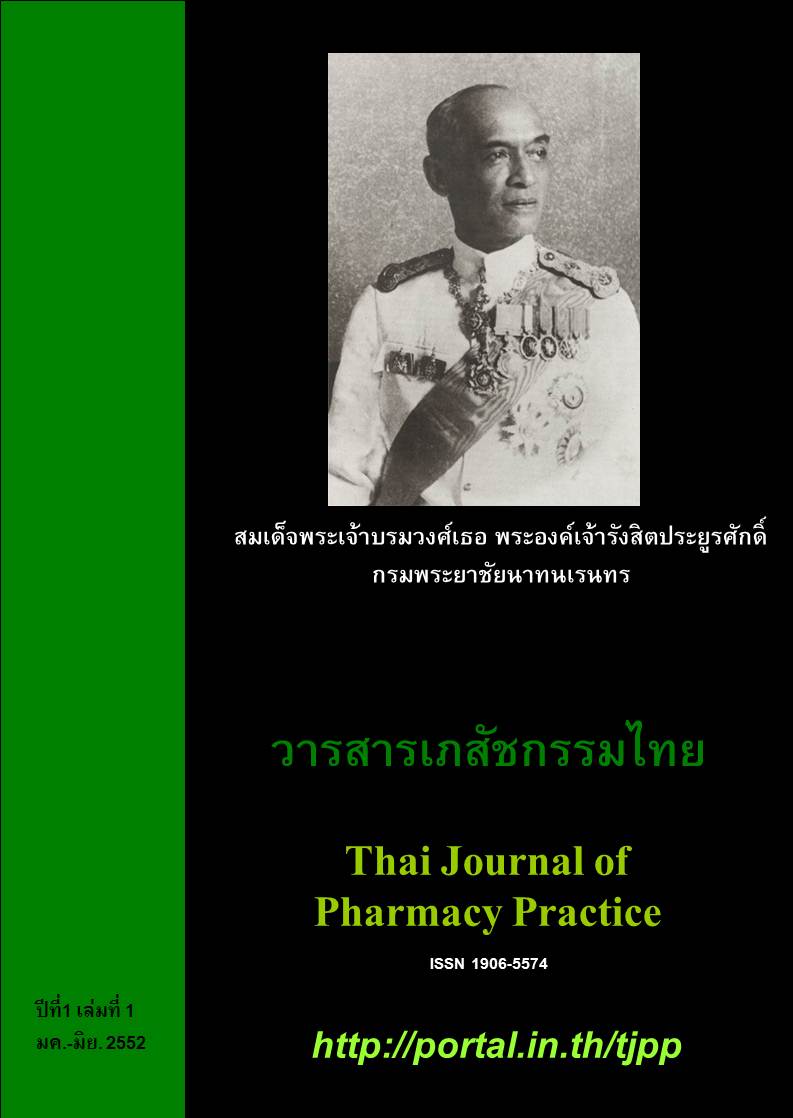ภาวะบีบคั้นทางจริยธรรม ตอนที่ 1: การทบทวนวรรณกรรมในเรื่องนิยาม ขนาดปัญหา ตัวแปรเหตุและผลที่ตามมา
Main Article Content
บทคัดย่อ
บทความมีสองตอน ตอนแรกทบทวนวรรณกรรมเรื่องภาวะบีบคั้นเชิงจริยธรรมในประเด็นของนิยาม ขนาดปัญหา ตัวแปรเหตุ และผลที่ตามมา บทความตอนที่สองจะกล่าวถึงเรื่องการวัดตัวแปรดังนี้ ในปี 2002 นาธานเนียลนิยามภาวะบีบคั้นเชิงจริยธรรมว่าเป็น “ความปวดร้าวเมื่อบุคคลทราบว่าตนเองตกอยู่ในสถานการณ์ที่มีปัญหาทางจริยธรรม และเชื่อว่าตนต้องรับผิดชอบกับสถานการณ์นั้น พร้อมกับได้ตัดสินใจแล้วว่าการกระทำที่ถูกต้องควรเป็นอย่างไร แต่มีอุปสรรคทั้งที่เกิดขึ้นจริง หรืออุปสรรคในการรับรู้ของตนทำให้ต้องทำในสิ่งที่ตนเชื่อว่าเป็นสิ่งผิด” ภาวะบีบคั้นเชิงจริยธรรมเป็นปัญหาที่พบมากในวิชาชีพพยาบาล การศึกษาในอดีตพบว่าพยาบาลร้อยละ 33-80 กล่าวว่าตนเผชิญกับปัญหานี้ นอกจากนี้พยาบาลที่ลาออกจากงานร้อยละ 15-26 กล่าวว่าตนลาออกจากงานเนื่องจากปัญหานี้ ภาวะบีบคั้นเชิงจริยธรรมเกิดจากสามสาเหตุใหญ่คือ สถานการณ์ทางคลินิก ปัจจัยที่เกี่ยวกับตัวผู้ให้การพยาบาลเอง และปัจจัยแวดล้อมที่ ไม่เกี่ยวกับตัวผู้ให้การพยาบาล บทความยังกล่าวถึงผลกระทบเชิงลบของภาวะบีบคั้นเชิงจริยธรรมต่อสุขภาพกายและใจ คุณภาพการรักษาพยาบาล ความยึดมั่นในเรื่องจริยธรรม ความเหนื่อยหน่ายต่องาน ความพึงพอใจในงาน และการลาออกจากงาน
Article Details
ผลการวิจัยและความคิดเห็นที่ปรากฏในบทความถือเป็นความคิดเห็นและอยู่ในความรับผิดชอบของผู้นิพนธ์ มิใช่ความเห็นหรือความรับผิดชอบของกองบรรณาธิการ หรือคณะเภสัชศาสตร์ มหาวิทยาลัยสงขลานครินทร์ ทั้งนี้ไม่รวมความผิดพลาดอันเกิดจากการพิมพ์ บทความที่ได้รับการเผยแพร่โดยวารสารเภสัชกรรมไทยถือเป็นสิทธิ์ของวารสารฯ
เอกสารอ้างอิง
2) Wilkinson JM. Moral distress in nursing practice: experience and effect. Nurs Forum 1987-1988;23:16-29.
3) Jameton A. Dilemmas of moral distress: moral responsibility and nursing practice. AWHONNS Clin Issues Perinat Womens Health Nurs 1993;4:542-51.
4) Fowler MDM. Moral distress and the shortage of critical care nurses. Heart Lung 1989; 18:314–15.
5) Fenton M. Moral distress in clinical practice: implications for the nurse administrator. Can J Nurs Adm 1988;1:8-11.
6) Davies B, Clarke D, Connaughty S, Cook K, MacKenzie B, McCormick J, et al. Caring for dying children: nurses' experiences. Pediatr Nurs 1996;22:500-7.
7) Erlen JA, Sereika SM. Critical care nurses, ethical decision-making and stress. J Adv Nurs 1997;26:953-61.
8) Hamric AB. Moral distress in everyday ethics. Nurs Outlook 2000;48:199-201.
9) Nathaniel A. Moral distress among nurses [Online]. 2002 [cited 2007 Jan 2]. Available from: URL: www.nursingworld.org/ethics/update/vol1no3a.htm.
10) Corley MC, Selig P. Prevalence of principled thinking by critical care nurses. Dimens Crit Care Nurs 1994;13:96–103.
11) Redman BK, Fry ST. Nurses' ethical conflicts: what is really known about them? Nurs Ethics 2000;7:360-6.
12) Soloman M, O'Donnell L, Jennings B, Guilfoy V, Wolf SM, Nolan K, et al. Decisions near the end of life: professional views on life sustaining treatments. Am J Public Health 1993;83:14-23.
13) Millette BE. Using Gilligan's framework to analyze nurses' stories of moral choices. West J Nurs Res 1994;16:660-74.
14) Corley MC. Moral distress of critical care nurses. Am J Crit Care 1995;4:280-5.
15) Corley MC, Elswick RK, Gorman M, Clor T. Development and evaluation of a moral distress scale. J Adv Nurs 2001;33:250-6.
16) Corley MC, Minick P, Elswick RK, Jacobs M. Nurse moral distress and ethical work environment. Nurs Ethics 2005;12:381-90
17) Kelly B. Preserving moral integrity: a follow-up study with new graduate nurses. J Adv Nurs 1998;28:1134-45.
18) Perkin RM, Young T, Freier MC., Allen J, Orr RD. Stress and distress in pediatric nurses: lessons from Baby K. Am J Crit Care 1997;6:225-32.
19) Krishnasamy M. Nursing, morality, and emotions: phase I and phase II clinical trials and patients with cancer. Cancer Nurs 1999;22:251-9.
20) Anderson SL. Patient advocacy and whistle-blowing in nursing: help for the helpers. Nurs Forum 1990;25:5-13.
21) Erlen JA.. Moral distress: A pervasive problem. Orthop Nurs 2001;20:76-80.
22) Hefferman P, Heilig S. Giving "moral distress" a voice: ethical concerns among neonatal intensive care personnel. Camb Q Health Ethics 1999;8:173-8.
23) Rubin J. Impediments to the development of clinical knowledge and ethical judgment in critical care nursing. In: Benner P, Tanner C, Chesla C, editors. Expertise in nursing practice. New York: Springer Publishing; 1996. p.170–92.
24) Baggs JG, Schmitt MH. Nurses’ and resident physicians’ perceptions of the process of collaboration in an MICU. Res Nurs Health 1997;20:71–80.
25) Raines ML. Ethical decision making in nurses: relationships among moral reasoning, coping style, and ethics stress. JONAS Healthc Law Ethics Regul 2000;2:29-41.
26) Beauchamp TL, Childress JF. Principles of Biomedical Ethics. 5th ed. New York; Oxford University Press, 2001.
27) Redman B, Hill M. Studies of ethical conflicts by nursing practice settings or roles. West J Nurs Res 1997;19:243–50.
28) Sundin-Huard D, Fahy K. Moral distress, advocacy and burnout: Theorising the relationships. Int J Nurs Pract 1999;5:8-13.
29) Tiedje LB.. Moral distress in perinatal nursing. J Perinat Neonatal Nurs 2000;14:36-43.
30) Rodney P, Varcoe C. Towards ethical inquiry in the economic evaluations of nursing practice. Can J Nurs Res 2001;33:35-7.
31) Harding S. Value laden technologies and the politics of nursing. In: Sprecker SJ, Gadow S, editors. Nursing: images and ideals. New York: Springer Publishing; 1980. p.49–75.
32) Benner P, Hooper-Kyriakidis P, Stannard D. Clinical wisdom and interventions in critical care. Philadelphia, PA: Saunders; 1999.
33) Rushton C. Care-giver suffering in critical care nursing. Heart Lung 1992;21:303–6.
34) Hamric AB, Davis WS, Childress MD. Moral distress in health care professionals. Pharos Alpha Omega Alpha Honor Med Soc 2006;69:16-23.
35) Corley MC. Nurse moral distress: a proposed theory and research agenda. Nurs Ethics 2002;9:636-50.


